ORDINIS
HELENUM: SUPERHELENA PART FOUR
Continued from part
three. Footnote number 34
Comments on
the Legend of
Saint Helena
of Westgothia
Helena
says as how she...
is the first one and the last,
I'm the honoured one and the scorned.
I'm the prostituted and the holy one.
I'm the wife and the Virgin.
I'm the Mother and the Daughter.
I'm her whose wedding is grandiose
and I have not taken any husband on.
I'm Gnosis and ignorance.
I'm shameless; I'm ashamed.
I'm strength and I'm fear.
I'm foolish and I'm wise.
I'm godless and I'm one whose God
is exceedingly great".
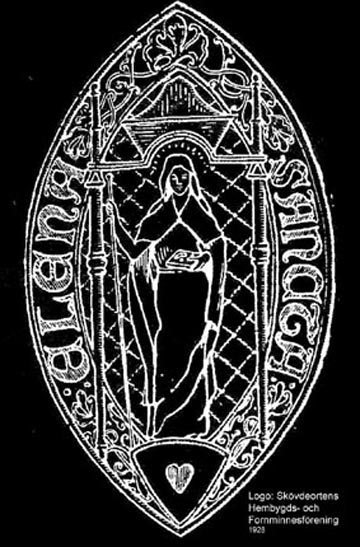
***34***
-- YEARS
OF GREATER OR LESSER IMPORT
TO
THE HELENIC CULT:--
**ca.1200
before Christ: Helena, meaning an interlaced basket, and Helenion, meaning
a small ditto, were firstly fixed in writing - namely on the island of
Peloponnesos/ Greece. Helena is a woman's name; Helenion is the Inula-plant
family, 'krissla' in Swedish.
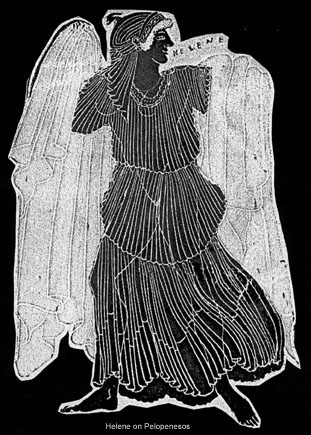
**ca.800 before Christ there was Helena's Shrine at Therapnae on Peloponnesos, and on Rhodes and at Tyre/ Lebanon there were Helena's Fanes.
**ca.300 before Christ: A picture of Helena - standing next to Menelaos - was made.
**400-500 A.D., between: A mosaic describing the Return of Helen To Greece was created, which since the 13th century is the floor of the cathedral of Pesavo in Italy.
**~1083 queen Helena, who falsely is mentioned as the owner of Axewalla Fortress (which didn't provably exist until in 1277) and truely as pious and being a native of Skovde, she burned down the temple of idolatry at Upsala; 21/1763f.
** 1102 our Saint Helena was born. (or: maybe in October 1101?).
** 1104 pope Paschalis II created the archdiocese of Lund.
** 1108, 15/2, "all Sweden became all Christian"(according to OFM) (Gothia had been christianized since 1072).
**1117 Helena wedded Bengt-the-Chevalier (according to a play. The first "swedish" Benedictus, an ecclesiarch of Lund, was mentioned when he died 20/2 ~1150. The second one was bishop Benedictus of Scara, when he was elected in 1170).
**1120 there were 6 dioceses in the Country: Eskilstuna, Linkoping, Sigtuna, Scara, Strengnes and Vesteraas.
**1123 Sigurd Jorsalafar, king of Norway, crusaded in Smaland (not only Palestine was plagued).
** 1123 the crypt and the high altar in Lund were inaugurated.
** 1124 the occupation of Palestine was fulfilled, enabling pilgrimages thither.
** 1125 the church of Tibirke was inaugurated, built next to a well which was still detectable in 1935.
** 1125 +/- 10 years: Westgothian builders erected the nave, apse and tower-chambers of Kumlaby Church.
** 1126 the erecting of the stone-cathedral of Scara was commenced, replacing the prior, wooden one. Its crypt did exist in 1064 - it was destroyed in 1250.
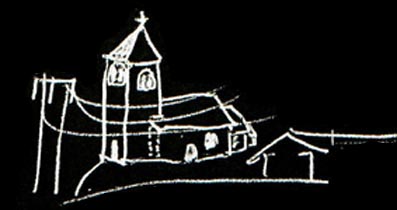
** 1130 Helena built the church at Womb, replacing a hypothetic, at least 530 years old, pagan temple at the big rural village of Womb.
** 1130 Westgothians got rid of the uplandian anti-king Knaphovde. Acc. to tradition this assault took place in Karleby/ Falbygden, where one of the dolmens has his name.
** 1132 Helena's daughter, whose name factually was Cecilia, unfortunately married the posh paynim, and moved to Westerby.
** 1134 king Magnus Nilsson, daughter's-son of king Inge the Elder, was killed in battle at Fotevik.
** 1135, 13/8, it would have been more than possible that Helena had attended the inauguration of Forsby Church, if only the inscription of this date there had not been a falsification.
** 1136 three loaves were transmogrified into stones in Her hands.
** 1137, 35 years of age, Helena was widowed. About the same time her daughter took the veil after her husband had been liquidated.
** 1138 king Sverker the Elder founded the Cathedral of Upsala. His Family and Party were pro-papal.
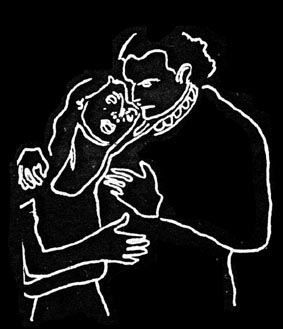
Helena
and Pope Innocentius II, 1138
** 1138-40 Helena peregrinated. She sailed off from where, 50 years later, the city of Ystad was founded. She met pope Innocentius II somewhere in Europe.
** 1138 Innocentius II reestablished Lund's archdiocese, which he'd tucked in under Hamburg-Bremen 5 years earlier.
** 1139 The city of Ystad was marked out on a map on the order of Roger II of Sicily.
** 1140, 1/8, Helena became the first female martyr of Sweden, 38 years old, in the neighbourhood of Gotene Church. During the following time there were a number of wonders occurring, mainly at Her Grave and the Rinsing-Boulder. "Pilgrims started to go here to the church which was called S.Elinae, and to the chapel at a source near Kaellegaarden, which was dedicated to the memory of this saint". Dunney has calculated that the correct year was 1147! 1140 was mentioned by ecclesiastical documents of Scara and Linkoping dioceses in the early 15th cent.; by Lagerbrings Sv.R.Histor 2 del s 147; twice by PE Lindskog 1812-16; by Forssenius, Messenius and Vastovius.
** 1140 One started to re-design Helena's Church in Skovde - (if true, before it was even finished) - to turn it into a collegiate church - the central sanctuary of the region, and the ecclesiastical authorities were centralized here. The oratory at Wombo Rivulet was built (and at least eight other stone-churches within reach). Helena's church looked just like the original stonechurches of Linkoping and Vreta (inaugurated in 1289 by Magnus Ladislaus), which was a consequence of the Eastgothian pro-papal support to the helenic cult; Skovde church is older than Vreta's, and therefore Vreta is modelled after it and not vice versa. Skovde was the "mother" of the annexes in the pastorate: Forsby, Hagelberg, Hene, Kyrketorp, Ryd, Suntetorp, Sventorp and Womb.
** 1145, 1/9, the Lund Cathedral was inaugurated.
** 1150:ies: according to a span-new statement Medelplana church was inaugurated then, and its helenic and apolline altars too.
** 1150 In Older Upsala, by king Sverker the Elder's anti-king Erik (of the anti-papal politics), the OSB-cloister was founded, wherein the arch-chapter was housed 1164-1220.
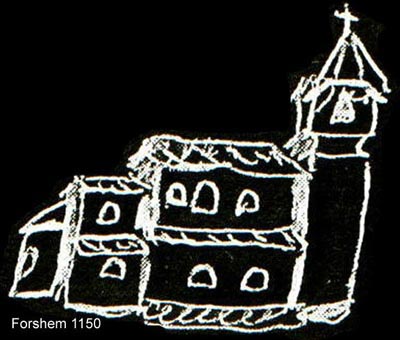
** 1150 Forshem Church (or the church which owned the relievoes originally) was depicted on a stone-relievo. The altar was furnished with a relique.
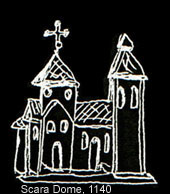
** 1151 Scara Cathedral was inaugurated. A contemporary depiction of it still exists.
** 1152 the Church of Sweden was brought closer to the pope through the Linkoping Synod.
** 1155 according to OSB-Cist - erik reigned in Westgothia?
**1158: Karl Sverkersson, the great promoter of Helena's Cult, had become king of Eastgothia and was approved of by the pope; in 1161 he had become king of all Sweden, in 1164 entitled king of East- and Westgothia by the pope; murdered on Isle of Vising by the erik-clan in 1167, 12/4.
** 1159/60 erik was disposed of.
** 1160:ies: 1.Helena was already venerated in Denmark (in benevolent theory, cf 1430 below!). 2.Guthorm Jarl's daughter Helena was named after our Helena. 3.The oldest swedish historical known writings were done - apart from runes.
** 1161, 4/2, our then-right king Magnus Henriksen got killed - the son's-daughter's-son of king Inge the Elder.
**1163-65 Alexander III, our favorite and ever-blessed pope, lived at Sens during his exile.
** 1164 on the first Saturday of August, Stephanus of Alvastra was made the first swedish archbishop in Sens/France by revered pope Alexander III and the archbishop of Lund Eskil. (In 1167 he had to flee to Denmark; visited the pope in 1169; in 1176 he inaugurated a church on Botwid's grave). (Sens was the Centre of the Christian World during the 12th century, but the cathedral wasn't finished in 1164 - its choir was inaugurated this year).
** 1164, during the Autumn, Stephanus, at Alvastra, on order of holy Alexander III, canonized and enshrined Helena - measures that were very much approved of by king Karl Sverkersson. Primarily Helena's Day was fixed on 31/7. She cannot have been elevated until the following century, though.
** 1167 and onwards swedish royal letters, donation-deeds, ecclesiastical and other documents were written which are still preserved.
**1169 the first bishop of Vaxio Diocese, known by name, Balduin from Denmark, is mentioned, after venerated Alexander III had reorganized this ancient diocese, first established in ~980.
** 1170 the stone-cathedral of Vaxio was ready. It had firstly been situated there by Una-, Suna- and Winaman in the 980:ies, and subsequently their head-reliques PROPHESIED inside the church. (Before 1021 king Olof gave the rural villages of Hov and Kronoberg to the planned cathedral, according to the Westgothian Law).
** 1170 Sunniva, Helena's liturgical sister, was laid in a silver shrine in Bergen Cathedral.
** 1171 Guthorm Jarl was mentioned the last known time in writing.
** 1172 - (before 1172)- 31/12, "Regina Elena" died at Vreta Cloister, daughter of Sverker the Elder, widow after Knud Magnusen who was the daughter's-grandson of Inge the Elder.
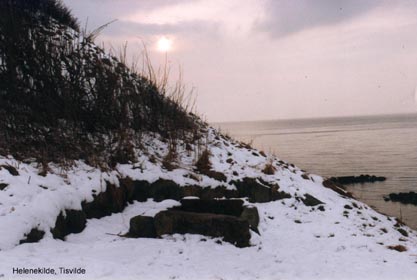
**1170:ies - the augustinian cloister of Aebelholt, Sjaelland, was founded, and maybe they owned the area which included Helene Kilde. When Tisvilde was mentioned in a writ during the superseding centenary, its name still had a liaison to the demigod of Tyr and none to Helena.
** 1190 Helena Guthormsdaughter married Esbern Snare, who was 33 years older than she. They lived close to Tisvilde at Saeby/Soeby Farm.
** 1191 the helenic reliques were laid into the altar of Gumlosa Church under construction. They comprise two sets, one probably connected to Helena of Auxerre, the other to Helena of Bruxelles(?).
** 1191 the Vaxio District was transformed from the influence under Lund's Archdiocese to the same under Upsala's.
** 1200 Helena Sverker-the-Younger's-daughter, who became the owner of Gum Farm between Odeshog and Alvastra, was born.
** 1204 Helena Guthormsdaughter's husband Esbern Snare fell backwards down he stairs in their farm Saeby on Sjelland and died.
** 1219 Snorre Sturlasen visited Eskil the Legislator in Westgothia.
** 1220/21 the Chapter in Scara was ordered from Rome (Vatikan) (by dint of a fairy's wand?) to be established - otherwise the Gothian Chapter was situated in Skovde.
** 1223 (or just after) Our Lady's Chapel and its Prebend were founded in Linkoping by Helena G.dtr and her son Knud of Reval. The foundation was referred to by a papal letter of 1232. (There isn't one iota left of the Linkoping Cathedral of their time above groundlevel).
** 1234 a reduction of the number of churchbuildings was carried out with papal permission.
** 1230:ies (at the earliest) Helena G.dtr was buried inside Linkoping Cathedral, at least 70 years old - the grandmother's-mother of S.Holmger, and the mother of the grandfather of Ingrid Svantopolksdaughter, etc.
** 1240:ies: Brynolf Algotsson was born. At this time the helenic cult was on the wane in Westgothia. The Rinsing-Boulder was transported away from Skovde by the erik party. Chez Alvastra cloister in Eastgothia the cult did survive though, thanks God.
** 1240-51, within this period, Helena Sverker-the-Younger's-daughter died and was buried in Alvastra cloiser.
** 1250 S.Helena's name entered Strengnes' calendar. Provably the cult of Helena had started in Sweden before Brynolf Algotsson was born.
** 1251 the helenic cult of Tibirke parish waxed greatly. Through Her wellwater ocular diseases were cured. It was presumed by Pontoppidan that Helena's holy body had been transferred thither from "Skedevig" during king Abel's time (born after 1214; king 1250-52), and if it were true, it had left Sweden when bishop Brynolf was just a kid of a few years. Was Pontoppidan's invention benevolent or malicious? Both in Sweden and in Denmark the protestants invented lots of catholic keepsakes such as "medieval" monuments and traditions. Cf 1430 below. Provably Helena's body stayed in Westgothia until half a century after the reformation.
** 1255 (until the 1530:ies) the Johannites of Eskilstuna venerated St. Helena, ranking her the highest possible with their Duplex-Grade).
** 1264 is an alternate year proposed for when "monks stole Helena's body from Skovde and brought it to Tibirke"; a doublet of 1251 above, caused by the author's inaccuracy when he in 1764 referred backwards 500 years in time.
** 1273 Upsala moved to its present position. On 24/1 erik's carcase got brought over there.
** 1281 the reverence-worth bishop Brynolf #1 lifted up the holy Elin's Mass. He polished up and reactualized Her cult. In writing "... In Skodwe Um Aelinaer Maessu..." in Skovde on Elin's Mass... he thereby produced the oldest written document known outside Denmark wherein Skovde and Helena are mentioned!
**1282 was Womb's Church firstly mentioned as Hvam.
** 1288 Brynolf wrote Helena's Liturgical Text after his sailing from Alvastra to Vanaas Udde - according to witnesses during his canonization-process of 1417.
** 1292 Una- Suna- and Winaman were depicted on the waxen seal of Vaxio Chapter.
** 1298 Brynolf started building the bishops' fortress Laecko (burnt down in the 1470:ies).
** 1299 Brynolf gave his maternal heritage in Womb to Scara Cathedral.
** 1314 (before this year) monks produced the proto-City Seal of Skovde, dominated by a true Helena-image. In 1314 her waxen, copied seal was hanging attached under a document.
** 1317 Brynolf #1 died.
** 1335 king Magnus Eriksson used Elin's Day for dating a letter sent from Lodose to Riseberga cloister: "die beate Helene".
** 1344 "Virgo Helena from Wattlosa" was included in the Upsalian Reliquary Inventory.
** 1346 king Magnus Eriksson and queen Blanche included Helena's Church/Skovde in their last Will and Testament. This was the first time Ecclesie Skodwi was mentioned. And Henry Ludvigson, a canon at Upsala, did the same in this same year.
** 1350, re 31/7, Helena's martyrdom was described by Wadstena Cloister.
** 1350 Helena was included in the liturgy of the Scara Cathedral, and also in the OP. calendar at Aabo.
** 1352 Womb's Church was laid waste, maybe by the danish warriors and/or by the pestilence. Everything which wasn't combustible remained standing, though - the church is still there.
** 1356 "Ecclesie Sancte Helene in Skodwi" and "in parochia Skyth" were written.
** 1357 and -58 Helena's Day was used for dating documents.
** 1358 bishop Nicolaus from Colland added Helena's Day, 31/7, to the Scara Calendar.
** 1358 there existed a Skovde Landsting (General Council).
** 1358-86, during this period, Skovde did flourish; they were the years of Nicolaus' episcopate.
** 1373 an Indulgence-letter of 40 days was written concerning Helena's Well and Oratory at Wombo Rivulet, and the Oratory was reported to be repaired. (The document was endorsed by the Scarensian bishop Nicolaus at Helena's church in Skovde on the Tuesday after Octaua apostolorum Petri et Pauli 6/7, interpreted as 12/7).
** 1380 farmsteads in Hene were donated to Helena's Church/Skovde. Maybe this was when it was first completely rebuilt and reshaped - one of many total transfigurations.
** 1389 Helena was endowed with a liturgical, birgittine text in Wadstena cloister.
** 1396 it was decided at Arboga Synod that thereafter and forever Helena was the Patron of all Sweden!
** 1397 premises in Havstena were donated to the renewal of Her Church.
**1398 one of the ~214 species of Helena's own flower-family, Inula, was mentioned in England for the first time: "Enula is an herbe and is oft callyd Enula Campana", id est Inula Helenium.
** 1399 some folks guess was the year when Skovde received its City Privileges.
** 1400 and a number of years: Helena was included in a psalterium and in litanies of the OSB-Cist.order. She was included in Hemsjo Manual. In due course she was introduced in all swedish dioceses, Aabo included. Her famous Grating (Gate) was made, used either as a portcullis before her alleged grave-niche, or as a gate to the choir. Maybe sometime after 1450 the church was furnished with a bricky tower, and also with the monument of S.George and the Dragon.
** 1400 the farm Lunden was donated to the "construction of a TEMPLE" in Skovde.
** 1400 the Helena Officium in Codex Laurentii Odonis was written by handwriting, "Gotene" inclusive.
** 1413 Skovde was regarded as a town.
** 1416 one more farm in Hene was donated to Her Church.
**1417 a version of Helena's Legend was presented in connexion to Brynolf's canonizational process.
** 1425 an Indulgentia of 40 days was written by the Scarensian bishop Sigge concerning Her Well and Oratory anew; endorsed at Skovde on 23/10, Saint-Seurin's Day.
** 1425-95 the pulling-contest betwixt Helena and Birgitta took place as to the sacred government of Skovde. Helena won, thanks God.
** 1429, 18/6 (on Helena of Bruxelles' Day), the archbishop of Lund, Peder, yielded an Indulgentia re Scara Cathedral for Helena's Day 31/7.
** 1429 a helenic prebend was created at Scara Cathedral.
** 1430 (approx.) the helenic well of Mariager was inaugurated, see K 46 of Royal Library/ Stockholm; AF Schmidt in Fortid og Nutid V 1924-25 p.140. On 31/7 "widow Helene" was included in their Calendar of Saints used from the second half of this century and onwards, and this inclusion of theirs purports the first documentation of Saint Helena in the area that Denmark of today comprises!!!.
** 1430 A picture of Helena was chased on the brassy plate on Henrik's cenotaph in Flandern.
**1435 Indulgentia re Her Church/ Skovde.
** 1436 Indulgentia of 40 days re Her Church/ Gotene was endorsed 19/11 at Wattlosa by the Scarensian bishop Sven. This is the first written proof of that this here church had been dedicated to Her!!!
** 1440, 20/11, the helenic altar in Upsala Cathedral was inaugurated. She shared it with Anna, Birgitta and Elisabeth of Hungary.
** 1448 an Indulgentia of 40 days by the archbishop, re those who pray Pater Noster and Angelus infront of the pictures of Christ's Grave and of one S.Helena in Upsala Cathedral.
** 1462 Indulgentia of 40 days re Her well and the site of her martyrdom at Gotene, yielded by bishop Laurentius of Wexio: fontem S.Helene et locum interemptionis in Gothene. Alas this indulgentia seems to have been invented in 1708, see the same.
** 1467, 27/1 (on Julianus of Le Mans' Day), Her Church at Skovde was mentioned in a document.
** 1473, 10/1 (on Guillaum de Donjeon's Day), Her Church at Skovde was mentioned in a document.
** 1480 Indulgentia re Her Church/ Skovde.
** 1480 Indulgentia re Her Church/ Gotene by Bishop III Gerlaksson on 1st Advent Sunday.
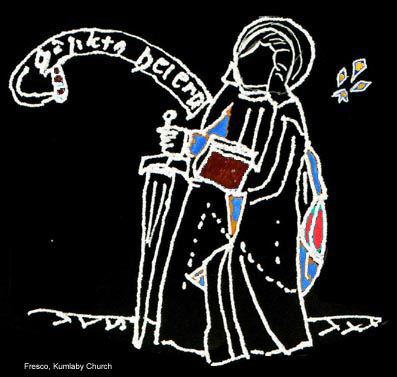
** 1482 (+/- 3 years) Helena was painted on the wall, furnished with a banner reading her name, in Kumlaby Church on Visingso, see 1922.
** 1492 bishop Brynolf #1 was canonized or beatified.
** 1498 another helenic prebend at Scara's Cathedral was notified. The Cathedral itself was dedicated to Mary.
** 1498 Helena's Day became one of the greatest feasts in Sweden.
** 1498 the Helena Officium in Breviarium Scarense was printed, "Gotene" inclusive.
**1498 A Helenic Pilgrim's Badge was soldered on a bell in Fredberg's church.
** 1500 (or a few years before 1500) most of the "old" helenic pieces of art were produced, as we guess today, and most of the wooden figurines seem to be made by the same carver.
** 1509, 18/10 (on Luke's Day), Indulgentia re pilgrimage to Her Church/ Skovde, yielded by Vincentius Henningsson, the last bishop of Scara 1505-20.
** 1512 and onwards, every tuesday a helenic Collect was prayed in Aebelholt's cloister (OSA). Theirs is the first documentation of helenic cult on Sjaelland ever, cf 1430 above: Script. rer. dan., VIII p.285, 300; V p.378; VI p.213.
** 1520, a rhymed Chronicle was written: "...aff Skoedwe then hellige ffru sancta Elin...(the holy lady saint Elin from Skovde)".
** 1526 City Privilege Letter was given to Skovde.
**1529 Helena was adopted liturgically by the O.Bridg in Altomünster, Ms.415 (55 g 13) in the library of Monast. b. M. v.ad Scot in Wien. The O.Bridg had included Helena in a Missal of their hospital at Rome (Cod Vat lat.5742 Vat. Libr), and the A 36 of KB/ Holmia shows another birgittine adoption of Helena on the Continent.
** 1530 Helena's Church/ Skovde was plundered by the new government of Sweden.
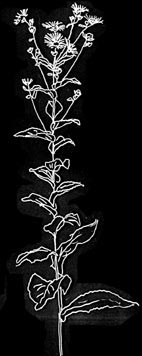
** 1533 canonicus Christiern Pedersen at Lund wrote that Inula Helenium is an effective antidote against poisonous snakebites. He based this statement on narrative of the exile of Helena and of the same plant on the island of Pharos off Alexandria, Egypt, which had occurred some 2333 years earlier.
**1540 the prebend of S:ta Helena at Scara Cathedral was mentioned in the diocesan proprietorial roll.
** 1541 the Angel's Revelation Chapel was torn down at Kolboda/Hagby parish (measuring 19 x 11 arms' length), once erected on the spot where Una-, Suna- and Winaman in around 980, after having landed on the Smalandic shores, the first night there had been told by an Angel to lay the basis of Vaxio's Cathedral centrally in Varend/Smaland.
** 1540:ies and -50:ies, during this period the Helenic Oratory in Tisvildeleje was torn down. Its ruins are wrongfully referred to as a grave. Investigations have proved that the "grave" is the 13th century oratory foundation. There has never been a grave there, though it has been suggested that the grave lay at a stone's cast from the ruin. (Nota bene: This entry discloses speculations, not facts).
**1568-77 Pierre de Ronsard wrote remarkable sonnets "pour Hélène", surpassing Homeros in Helenic worship. He gave her the title 'Goddess on Earth', inspired by the papal title 'Deus in terra'; thus he hesitated not in regarding Helena as Goddess!, thereby revealing himself as a true and praiseworthy Prophet.
** 1579 our swedish catholic martyr Johannes Messenius was born at Freberga/ Kaelvesten; wrote truthfully on S.Helena; two sons were executed, and he himself got imprisoned, because of their catholic faith; died in jail 1636 8/11.
** 1596 is perhaps the year when Helena's Holy Reliques were interred. The Silver Shrine itself was brought away from Skovde, one presumes, by Ab. Angermannus' "craftsmen". The expansion of Skovde was tampered with, and soon the decay started. "This is your moment; now the power of darkness rules".
** 1597 the Skovde School was founded.
** 1601 it was written in England that "Elecampane sprang first from, as it is said, the teares of Ladie Helena". The plant is Inula Helenium, see 1533 above.
**1605-16 Goteve (with a v instead of an n) was introduced into the helenic legend thanks to Sigismund III's Officia Propria.
** 1623 J.Vastovius invented that Helena had died in 1160 and that her father had been Guthorm Jarl - in his Vitis Aquilonia printed in Cologne; he also described S.Torsten of Wattlosa.
**1624 S.Helena's Well at Lyngsio was mentioned by the Prestrelationer.
**1627 Helena is called a Missionary in connexion to her well in Sjelland. The same year rector Stephanus of Slangerup writes that Helene Kilde had received its name for to honour "Mrs Elin" after the Christianization of Sjaelland had been fulfilled.
**1627 a tall cross at Helena's Well at Tisvildeleje bore this inscription: "On all of you who are coming here, sick or poor, may Jesus, the Son of God and of Mary, and St.Helene have mercy!"
**1634 Helena's Grave, and Her Nibs lying upon St. Helene Stone (the stranded rock), were described by Peder Lange, a priest of Helsinge, Sjaelland.
** 1636, 4/8, a girl, who had been bitten by a viper, drank in the name of the Lord helenic water from Her well at Tisvildeleje, and was saved.
** 1640:ies: King Christian IV (1577-1648) wrote that "by Lyngsio Bridge there's Sankt Elleni's Well, streaming right out of the earth with perfectly clear water. People keep visiting it, and there are many crosses erected there recently with hair attached to them and sometimes money too". The same king did seek healing by Helena's well of Tibirke parish too. It is doubt-inspiring that the first danish-scanian mentions on helenic sources use names like Ellenis or Helle Lene, since these names got nothing with Helena to do.
**1640:ies too: Liars invented "Sigfrid's Grave-lid" inside the Vaxio Cathedral.
**1647 Helena's offshore stone at Sjelland was described by Ole Worm: Sanct Leene had come from Sverrig and landed at Tybele; close to the shore there's a big, shapeless and brown rock, upon which people say that they've found marks showing how her hair lay, and there are impressions of her hips, hands and feet. The rock is in the water precisely where, on the shore, the cleavage of the steep brink is; one gun-shot from the shore not even wild horses could move her coffin - it turned that hefty that it sank into the soil where the "Grave" now is.
**1650 Erich Hansen, Graested, described Helene Kilde in his Fontinalia Sacra.
**1658 Helenic traditions were written down in Sjelland. Henricus Lindanus, SJ., sent this year an account from Kobenhavn to pater Bollandus on Sankt Helene Grave at Tisvilde, printed in Acta Sanctorum, July, VII, p.330: Every summer large numbers of pilgrims arrived at this holy place; the sick and limp stayed all night on the Grave, and often they left behind their crutches; they gave gifts of gratitude for having been cured, and they carried with them, as they left Tisvilde, small bags with earth dug from under the Grave's Stone.
** 1667 liars invented "Sigfrid's source" at Husaby.
** 1680 (or after) one informer says alternately that Helena's Reliques had been shipped from Karlskrona to the Vatikan.
** 1686-90 the Ruins of Her Oratory and Well at Wombo Rivulet were visited by Sven Jonsson-Tiliander throughout his time as a school-master in Skovde.
** 1687 a drawing was made by a geodesic clerk of Helena's Church/ Skovde. At this time it looked sorrowful. It had been without a roof for many years, and was repaired like a patchwork; 'twas out of proportions.
** 1693 Erik Dahlberg depicted S.Torsten's Well in Wattlosa (on copparplate).
**1700 - 1705 Johannes Messenius' helenic texts were printed, written during the first third of the 17th cent. See Scond. III. Tom.9 p.34.
** 1700 - 1730, during this period an attempt was carried out to fill the helenic well at Gotene with earth and stones, but it broke forth anew at some distance - as a FOUNTAIN. During this period Peringskoeld mentioned "Aelina Kyrkia" in Skovde; and before 1717 one copy of Helena's Guild-Badges wound up in Dalarna!
**1708 Erik Benzelius re-issued In Vite Aquilonia, see p.70. He seems to have been ruthless enough to invent the indulgentia of 1462, see above. His mention of St. Helena's Well at Gotene is the first one ever.
**1724 Holberg wrote a comedy, Kilde-Reysen, in which Helene Kilde at Tisvilde is included.
** 1724-26 Erick Wallmarck was a pastor in Skovde, like Tiliander and Linné, BEFORE the Firestorm. They saw Her Church like it looks on Filmer's drawing (1687); they saw thus no transepts, but they did see an apse; they walked through the roofed Gateway on entering the cemetery. Erick Wallmarck had made acquaintance with another helenic parish too, namely 1709-24 with Bjorkang!
**1725 sand was busy covering Sjaelland, Tibirke parish included.
** 1730, 1/11 (All Saints' Day) the greater churchbell broke in two in Helena's Church/Skovde - "a salute from all the saints who, at that time, were being denied!"; "a pedagogic punishment!" (All 3 present bells were moulded in 1908).
** 1734: all traces of Helena were gone from Her ex-church. Her Grave was empty. Only a catholic Incensory remained, hanging by its chains (until it was melted away by the coming Firestorm of 1759).
** 1734 E.Frondin at Upsala printed in De Schedvia the two famous Indulgency-letters of S:ta Helena's Oratory near Skovde of 13730712 and 14251023 - and the equally important one of Her Church at Gotene of 1 Advent 1480.
**1734-36 Anders Forssenius wrote about Helena and Skovde in latin: Disputation de Schecvia, see P.II p.59f.
**1743, 13/7, Rasch calls Helena a Danish Princess, cf 1843. He also tells that her Kilde at Tisvilde is a double-well - it still is! It seems as though this was the year when Helena's hypothetical familymembers of Scania and Denmark were invented.
** 1744 - "St. Helenes Kilde paa Torget havde allerede ved 1740 tabt sit Ry for Hellighed", id est Her well of Nordlands Amt on the westcoast of Norway.
** 1746, 27/6, Carl von Linné wrote while visiting Skovde: "This town was Sanctae Helenae See in days of Yore".
** 1750:ies: the ink-drawing was luckily made of Her Oratory at Wombo Rivulet.
** 1754, 9/9, queen Lovisa Ulrika stopped the royal carrosse when she caught sight of the grievous ruins of Helena's Oratory, and she walked unto it and proved its walls and vaults her pity. (Lovisa's husband didn't bother to leave the carrosse).
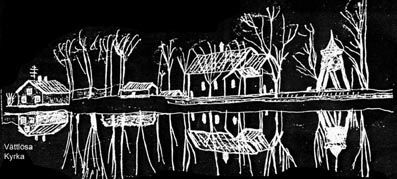
** 1756 Wattlosa Church was enlarged, and medieval parts were destroyed.
** 1756, 8/9, danish fishermen were able to detect Helena's undescribably wonderful perfume from Her balmed body, at the ruins of Her Oratory at Tisvildeleje.
** 1759, 11/9, all of Skovde burned down, and Her church was badly damaged. Then the Oratory ruins were 100 % wiped out above groundlevel, since its stones were re-used in building the adjacent bridge and the church downtown."Thy servants, Helena, love the stones of thy Temple, yea, we are even attached to its gravel and dust (Ps.102:15)".
** 1767 GH Barfod made a drawing of S.Helena in Skovde.
** 1769 and for a few years, there was a painting of Helena, clad as a nun (O.Praem.), outdoors on the upper part of the southern side of the tower. A truely clever initiative, but of course an ambitious blacksoul made sure it was taken away. The whole tower tumbled down once before it was finished, and it wasn't re-erected until in 1828.
** 1782 Womb's Church was restored and re-inaugurated. (In 1744, acc. to cacodoxy, its Prime Bell had been moulded, used until 1796 in spite of the prohibition of ringing such when the Lord's Supper is celebrated).
**1790 a memorial sheet metal plate was nailed on the wall of Womb's Church, reading: "It is plausible, that Saint Helena owned this soil through paternal heritage, and that she has lived here, wherefore the village has received the name Our Lady's Foyer; and that she did build this Temple in the year of 1130 for her devotions and to the honour of Mary the Virgin". The plate was still there in at least 1861.
*'1812-16 PE Lindskog mentioned twice the correct year of Helena's Martyrdom - 1140! He also mentions Appollonia's Well on Little Meadow at Bestorp/ Medelplana.
**1814 Helena's sjellandic legend was written down. The same year Just Matthias Thiele, during a visit to Sankt Helene Brond ("draw-well") at Tisvilde, heard the narrative from the lips of a peasant's daughter quoted earlier in the Collectary; by Joseph Dunney; in Black Book p.680; and in danish, verbatim, by Tryggve Lundén in Credo Magazine.
**1843 Helena is called a Scanian Princess by J.M. Thiele.
** 1850 there was a wooden statue of Helena at her Well at Tisvildeleje, but later (in 1872?) it emigrated to USA (brought by a mormon Elder, see below). Dunney calls it a statue of Virgin Mary, though.
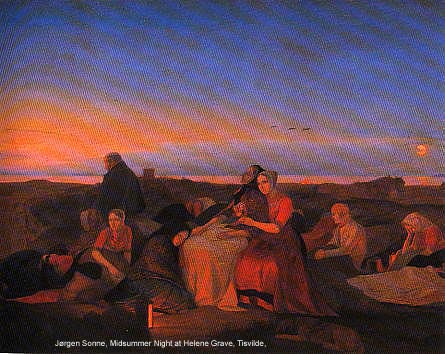
**1858 more Helenic traditions were described in Sjelland. The same year Jorgen Sonne made a drawing depicting the midsummer-ceremonies at St. Helene Grave at Tisvilde, and in A.Schmidt's booklet this and similar drawings of hisn and of others are reproduced, such as The Sleep of the Sick upon Helene Grave during Midsummer-night; the Fires of St. John are seen as a background.
** 1868, 15/8, J.C. Watson found, at Ann Arbor, the 101st asteroid, which name became HELENA!
**1885 A Chr Bang reminded the world of St. Helene Kilde on the norwegian westcoast island of Torget.
** 1888 the bear-portal of Her church in Skovde was mounted; the church was put in neat order.
**1895, some time before, the names of the four Scanian churches genuinely dedicated to Saint Helena were published in Denmark. At the same time it was stated that no church ever had been dedicated to Her west of the Sound separating Scania and Denmark - except for Her oratory at Tisvilde I premise - but perhaps, if Vilhelm Bang is all right here, it means that there is no document proving this latter, generally taken for granted, dedication.
**1898 Helena's Well of Medelplana had been known for decades.
**1915 Pehr Johnsson invented Helena's Second Pilgrimage and Gothem in 'Ur Vastergotland's Sagoskatt', chapter 'En Kvinnlig Pilgrim'.
**1915 B.Anrep-Nordin published in VFFT Sequences and Hymns to S:ta Helena.
**1916-20 fourteen oil-colour-paintings were made, showing the helenic cult at Tisvilde, by Ove Kunert (1893-1975), and they are preserved as wall-tapestries inside of his villa ibidem.
** 1922 the first helenic piece of art was rediscovered (apart from her Seals and escutcheons) - the 15th century mural painting in Kumlaby Church - thanks God!
** 1927 it was discovered that no less a beauty than Helena had been gazing over the church-goers of North Ny parish since 1764 from one of the shutters of the retable. Svenska Dagbladet, 9/7 1927: "..but the other saint, wearing a green skirt, bright red mantle and a white veil tied around her cheeks - who was she? In her right hand she held a sword, in her left a book of red covers. But on the book - what was lying there, looking strange? A finger, a lost finger. Holy Elin's wondermaking finger. Holy Elin - she was thereat rediscovered; was standing there with the memories of her painful, violent death, the sword and the finger; just as one might have expected to find her".

** 1927 Her Church in Skovde was renovated again.
** 1927 it was reported, 13/9, correctly that the Helenas of Rudskoga and Visnum had been rediscovered.
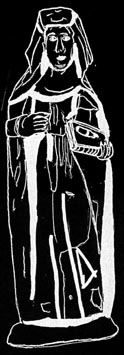
Helena, Rudskoga
**1930, in Oremus printed this year, the Collect of the 1:st Vesper of the brynolphian In Solennitate Sancte Helene was included: "31 July Sancta Helena, widow, martyr. Buried at Skovde, canonized in 1164. Ecclesiastical prayer:..."
**1931 Antonia Schmid adds a chapter on holy S:ta Helena in her sigfridian Book.
**1931 Sigismund III's Officia Propria was printed anew.
** 1932 a play, written by "von", was performed 2/7 and 3/7 at Varnhem: Spelet om Sancta Helena". Honestly, a totally lousy play, but hopefully it served as a reminder of Helena.
** 1932 a 12th century tomb was discovered under the floor of the tower of Womb's Church.
**1935 S.Helena's Well at Lyngsio was correctly connected to S.Helena of Westgothia. (In 1924 it had wrongly been connected to S.Helena of Drepanon, Constantine's ma).
** 1937 Joseph Aloisius Dunney, 56, Albany, USA, wrote Saint Of The Snows - A Chronicle of the Holy Elin of Skovde - after 10 years of research.
** 1938 Helena's holy finger-reliques from Molltorp Altar were given to Scara Museum.
** 1939 Skovde Commune Escutcheon was authorized.

** 1940 the Helena from Kullings-Skovde was identified (In 1878 a museum in Gothenburg had bought it for 25 kronor).
** 1940:ies: The Helena of Grasmark was identified. In 1877 it had been given to SHM/ Stockholm.

**1943 the memorial stone was erected on the ruins of Elin's Church/ Goteve: "Here Elin's church has stood. Raised 1943"; the priest of Elin used to live 2.000 m to the west of this church.
**1945 Order of Saint Helena was founded in USA. They now own 2 cloisters in New York and 1 in Georgia.
** 1952 the Helena of Onum was identified.
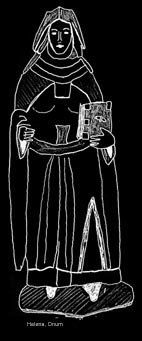
** 1953 Gotene Municipal Escutcheon was authorized.
** 1955 the basement vaults, medieval, of the alleged premonstratensian cloister/ Skovde, were destroyed, near the alleged Source of Darkness, as a new road-crossing was built. (A photo exists).
**1955 the monument including a stone-cross was set up by Saint Helena's Well by the Gotene Dairy.
** 1955 the Helena-play by Von was reperformed - now at Gotene. In 1957 it was repeated at Flyhov, Husaby.
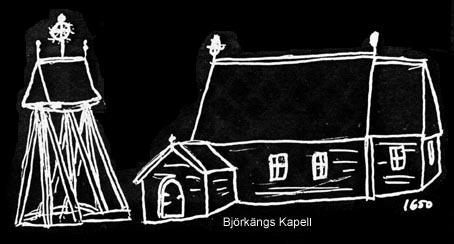
** 1956 the Helena of Toreboda & Bjorkang was reported, but the image had been identified some years earlier.
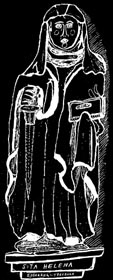
S. Helena, Bjorkang-Toreboda
** 1956 someone created the stained-glass fenestral Helenapicture of Scara Cathedral. She's holding a BLUE sword in her left hand.
** 1956 the memorial-stone at Her Well at Wombo Rivulet was erected. And about this time the "helenic Bible" was released: Det Aldsta Skovde Och Sankta Elin (the eldest Skovde and S.Helena)". This was a port of a helenic renaissance, thanks God.
** 1960:ies up to and including 1990:ies: Several helenic monuments were invented.
** 1971: An altar of 3 tonnes - the alleged helenic one - was placed beside the mainaltar of Medelplana Church. It used to be in one piece, but it's now in two pieces. For 150 years it had been resting in a field. Now it's used for a baptismal altar.)
** 1974: The sign at Elin's Well, beneath Medelplana's Bosgaard, was set up in July.
**1975 The Guild of St.Nicolai of Lidkoping wrote an article on S:ta Elin's Well in Medelplana in Lidkopingsbygden.
**1979, 16- or 23/3, the first post-reformatory Helenic Pilgrimage took place by O.Hel-in-spe.
**1980 the 12th satellite around Saturn was namned Helene; it's irregular and measures at the most 36 km or 22 miles.
** 1981: Jordan B. Jordanov from Bulgaria carved a splendid and admirable copy of Helena and her entire retable of Grasmark Church.Thus Helena can ever since regard the church-goers of Grasmark with new eyne!
** 1985, the hurricane of the year over the Mexican Gulf was named Helena.
**1987, 12/11, an important date for O.Hel-in-spe, Mariestad; 20/1612.
**1991 on 13/8 at half past 9 a.m., among the ruins of the O.Praem. Cloister at Dragsmark, the Ordinis Helenium was created.
**1992, 6-7/6 (an idealized date): "Helena is the Saint of Westgothia and she was born at Wattlosa"; "Helena was born at Wattlosa and she died at Gotene".
**1992 on 22/7 at a quarter to 10 a.m. the Initiatio into Helena's Cult took place.
**1992, October, a museum card was set in order at Kristianstad for Saint Helena's Well, 20 m above sea-level in Lyngsio parish, as N:r 87.
** 1993, 6/11, a pastor reinaugurated the well in the slope before Ranneslov's Mill. A sign now says "Helena's Kalla (Well)".
** 1994 a new and complete Saint Helena's Mass was composed, using the modern texts of the current Catholic Book of Mass, SDG! Helenic music corresponding to some 22 full-CDs'-length has been produced since then.
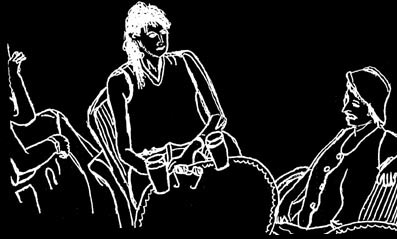
Saint Helene (left) and Saint Apollonia, Maastricht
in the summer 1994
**1996: One mural painting and ten relievoes were produced for an ecclesiastical building at Skovde, all possessing an allegedly helenic symbolism, referring both to Peloponnesos and to Westgothia (cf 33:15m).
**1996, at dawn 4/12, Helena was walking by another woman in a catacomb (or the tunnel of Amyklai?); she turned around and asked her prophet acridly: -Pourquoi me persécutes-tu? (Uriel answered ashamed: -I don't, do I?). The preceding evening he had accused GL for persecuting Helena by denying her very existence at the same time as he (GL) devotes his life to her Memorials. (Cf Ap.9:5, 22:7, 26:14).
**1997, 24/2, the first helenic internet material was launched.
**1997, at summer-time, there was an exhibition on Sankt Helene at Tisvildeleje.
**1997, the profane Midsummer Night of 20-21/6: Saint Helena appeared next to her holy well near Skovde at midnight and in full moonlight as a black cat, didn't she, after the completion of a helenic rite. 'Twas no wonder as how that cat created a highfalutin' state of mind then, since we really did believe that She had appeared felinely in 1391 during Midsummer Night at her well at Tisvilde, but this was an incredible mal-interpretation due to rashness of a few lines, on page 97, of A.Schmidt's booklet on danish sources. When these lines were re-read in March or April in 2001 it was revealed that Schmidt had noway claimed that, but that at St. Thoger's Kilde, registered as Number 1391, Thisted Amt, Refs Herred, on the ancient cemetery of Vestervig Church, a witch had [some time before the 18th cent.?] appeared, during the Midsummer Night, in the Likeness of a Cat, "i Katteskikkelse". Now, the cat of 1997 was a real cat, not a disguise, not even the reincarnation of some medieval cat; cf 2001 22-23/6.
** 1997, 16/8, 17/8, another Helena-play (with some music) was performed in Gotene. The directress had been guided by a dream to create some kind of manifestation there. The CD, used in the play, had been produced in S.Helena's Street/ Skovde!
** 1997, 9/9, all conceiled details of the evolution of the Helenic Cult of the 1990:ies was disclosed from Heaven except for the crucial question of whensoever, exactly, did La Grande Vision descend upon its two founders? (7) p.1 ff. The sentences are quoted above, see 1992 6-7/6, which is not a sure date at all.
** 1997, 3/10, a new S:ta Helena's Ring was made of silver at Skovde, see p.680; picture of it: 20/1547. It was skillfully made smaller at Twelfth-tide in 1998, ibidem.
** 1997: During that year it was planned to 1.create a park in Gotene, comprising a well and a RIDING HELENA. 2.to create another park there, comprising a stone relievo of Helena on the opposite side of the street of the existing relievo of Gotene's founder; and also a small pond, and to plant Inula ("Helenium") Flowers. 3.The Helena Marathon Race from Skovde to Gotene. And during that same year all three ideas were discarted! An inofficial helenic flag was designed, based on the french one, due to Helena's canonization documents being prepared in Sens/ France in 1164.
**1998 a clinic for girls suffering from anorexia was planned to start at Skovde - Saint Helena's Clinics, but two years later one still cannot find it in the telephone-book.
**1998 Saint Helena's Trophy introduced their Inter-Net pages - a yearly skating-tour. Saint Helena's Basket is a basket-ball team at Skovde. Saint Helena S-Society is a local Social-Democrat ditto.
** 1998, 10/5, a wooden figurine of Helena of Westgothia was set up at Salt Lake City. It looks like the other ones from about 1500, but is in good shape, has fresh wood in it, and it's surely a well-made copy. It had been taken there now in May from Huntsville/ Utah (or Hurricane?). Though I'd reported a Helena-sculpture missing to two Mormon elders in 1997 21/8 near Habo, I doubt that this newly eretced one is that one - which had been taken by a Mormon in 1872 (1850?) from Tisvildeleje to Salt Lake City. I rather believe that this Helena-scupture is to do with the gnostical church of the same city, which is the base of one of their three dioceses in USA.
** 1998, 30/9, Moly was purchased (the plant was still alive 30/9-00, but it had deceased by mid-November); 20:1676.
**1999, 13/7, a revisit to Orust Ang-island was carried out by O.Hel. Dragsmark's O.Praem-cloister and Elin's church-ruin too were revisited.
**1999, 15/7, a pilgrimage was accomplished to St. Helena's Well at Lyngsjo, Scania.
**1999, 21/9, Helena's alleged true well was detected at P:4 Regiment/ Skovde?
**1999, November, J.Dunney's helenic book was translated into swedish by O.Hel.
**2000, 3/3, Von's Helena Play was rewritten in modern and rhymeless Swedish.
**2000, 24/4, a pilgrimage was carried out to the places connected to the sisters and brother of Helena in Scania (and to Sjaelland).
**2000, days of June & July exempli gratia 29/6, are described on pages 13-15 in (11), id est the Seven Step Initiation into Gnosticism.
**2000, 3/7, Helena of Tyrus and her ancient Ism barged into Ordinis Helenum, and hundreds of ideas that we had had and had believed to be our own, proved to have been thought by Philon of Alexandria and other holy geniuses some 2000 years ago!
**2000, August-September, EM Gudvardarsen wrote at Tisvilde that Helen not had come from Sweden but directly from Greece to Denmark, and that she since then has and continuously does inspire the Danes.
**2001 in general: (A play concerning Helena was performed on the square infront of her church at Skovde after its bells had tolled and announced the New Year. 5-18/1 a play concerning Helen of Greece was performed by Skovde Theatre. 18/4 another alleged helenic play was performed inside Binneberg Courthouse. 21-29/4 yet another alleged helenic play was performed inside her church at Skovde. 6/6, during the royal visit at Skovde, the Binneberg-show was repeated. 31/7 a Saint Elin's Party took place at her Well by the Regiment P:4 of Skovde - all this might seem good, but it is not, since they've changed the truth for lies about our holy Saint).
**2001, 1/1, a new helenic Escutcheon of Skovde Commune replaced the one of 1939, and it is actually much better than that old one. The plain escutcheon is red. Helena is in its centre drawn with white lines; she's got a glory, a veil, a robe without creases, a wide mantle (making her look fat). Her left hand holds the cumbent book, on which her finger rests horizontally. Her right hand holds a sword pointing down. (A similar escutcheon is used by a sports society, but they've drawn her with the sword pointing upwards).
**2001, 22/1: "When you say that you worship me, it frightens me"; -"Why no, I mean no harm whatsoever".
**2001, 4-5/2: "God made Jesus apprear to mankind and God allowed the femineity". This piece of "information" was immediately interpreted experimentally as: "God has come down with Jesus to the human race, and Jesus granted equal room for the female consort by whom he was accompanied, and to all feminality, and he granted the worship of a Goddess equal to the worship of himself". In other words women are not entities to shun, a shunning which has occurred and still does among so-called holy men - to let alone the general suppression of women...
**2001, 6/3, a Helenic and Apolline Banner was made at Skovde in accordancy with my instructions and drawings - along with their mutual T-shirt.
**2001, 23/3, a pilgrimage was fulfilled to the three holy sites of St. Helene at Tisvilde & Tisvildeleje, Denmark. Skov og Naturstyrelsen has placed signs at Helene Kilde, Grav and Kildeblok with good, illustrated information on.
**2001, 12/4, a Mass was celebrated inside Helena's Farm in Vattlosa parish near the Gotene-border. (There is a Helena's Café in the room next to the ecclesiastical chamber, and its personnel wears T-shirts with 'Helena's Café' printed dorsally - all named provably after St. Helena of Gotene).
**2001, 23-24/4, the first gnostically helenic internet material was launched. It was originally a letter written by Uriel, the Prophet of Helena.
**2001, 23/5, helenists followed the footsteps of Helena on the vast sandy beach of Skummeslov.
**2001, 19/6, two helenists revisited Ang-Isle, and, together with a third entity: a supernatural Woman, they revisited Smogen.
**2001, 21/6 id est on Solstitium Aestivum, the first ever for SSHGO, and correctly performed, Labyrinth-ritual was carried out - "meet me in the Middle of the Year". The Inula-leaf that was brought along evidently caused the realization of the swedish belief that midsummer-flowers magically reveal to you your spouse-in-spe - it did to Uriel subsequently, who had a vision of two supernatural Women.
**2001, 22-23/6, the Midsummer Nite Rite of 1997 on Helena's holy Well outside Skovde was repeated, but this time it created no ecstasy, maybe due to the unveiling of the truth behind Helena's disguise in 1391 as a black cat. (A real black cat was seen thereabouts though). The night was mainly spent on the Paradise Hill, which has the likeness of an island analogously to Platanistas, above the meandering Wombo Rivulet.
**2001, July: Archaeologists of Iraq detected a temple built some 2800 years ago at Nimrod City i northern Iraq. Two stoney lions gard the entrance, like two do on each side of the entrance of Amyklai. The temple is dedicated to Goddess Ishtar, whose name just is another name of Goddess Helena, allegedly, but the comparison to Isis is a blasphemy. There's a big hallway leading to the wide, roofless court, paved with bricks, some of which are furnished with the symbols which date the temple.
**2001, 1/8, the alleged husband of Helena asked Uriël -"Will you not share bed with Helena while I go and sleep in the guest-bed?" He was murderously angry at Uriel's worshipping Helena! Before the Banquet there then was finished, before the night, Uriel hit the road...
**2001, 14/8, seven helenic and gnostic documents were introduced on internet.

**2001, 15/8, you could read in Gothene Newspaper: "The tall plant to the right is a healing herb which Saint Helena brought with her here to Gothene" - it is an Inula Helenium!, and thus the addition to the Collectio of Helena's Reminiscence goes on...
HAIL
HELENA, our Westgothian Saint
1:st ed. on "Gregorij pape et confessor" in 1999; 2:nd ed. on "Eupli m"
in 2001. S.D.G.
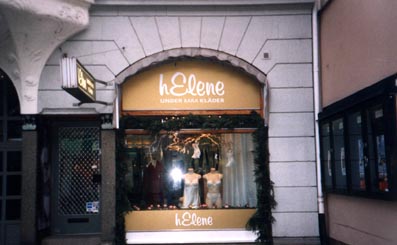
Helene (commercial), Malmö, dec. 2001
End
of Part Four
Go
to the appendix, Helenic Dialogue
Superhelena
Illustrated version:
Superhelena1
Superhelena
2 Superhelena
3 Superhelena
4
Appendix to part
4: Helena Dialoque
Contents
English
version
Non-illustrated
version: Superhelena
1 Superhelena
2 Superhelena
3 Epitome
Brynolf
Algotsson
about Helena, 1288
Innhåll
Superhelena svensk version
Superhelena
1 Superhelena
2 Superhelena
3
Brynolf
Algotsson om Helena, 1288 Sankt
Appollonia
Översättning af Joseph Dunney: Saint
Of The Snows
Albany, New York 1937 Snöfallens Helgon:
Förord
Dokument 1
Dokument
2 Dokument 3
Efterord